Overview
Features
- Industrial Grade Sensor with Range 0 to 100% RH / -25°C [-13°F] to 85°C [185°F])
- Resolution 0.04% RH/0.025°C
- Accuracy 4% RH/ 0.5°C
- 2 Mile Range with On-Board Antenna
- Superior LOS Range of up to 28 miles with High-Gain Antennas
- Interface to Raspberry Pi, Microsoft Azure, Arduino and More
- Example Software for Visual Studio and LabVIEW
- Wireless Mesh Networking using DigiMesh®
- 256 Sensor Node per Network
- Open Communication Protocol for custom interfacing applications
- Small Form Factor Wireless Sensor (3×3 inch)
- Two modes of Operation
- Configuration mode for Sensor and X-bee Settings
- Factory Default Option using combination of hardware buttons
- Power efficient Built-in Sleep mode
- User Configurable Sleep duration
- Up to 500,000 Transmissions from 2 AA Batteries
- X-bee API mode use for reliable communication
- Improved reliability incorporating Retry feature in case of packet loss
- Real time battery status
Applications
- In House Temperature Humidity monitoring
- Storage Unit Weather Monitoring System
- Warehouse Temperature Humidity Monitoring System
- Wireless Temperature Humidity Sensor For Crawl Space
- Temperature Humidity Sensor For Device Control Application
- Wireless Temperature Humidity Monitoring For Raspberry Pi/Arduino
- Component of Low Power IoT System
- Home Automation
Description
Introducing NCD’s long-range wireless temperature humidity sensor, boasting up to a 28 Mile range using a wireless mesh networking architecture. Incorporating the Honeywell HIH9130 temperature humidity sensor, transmits highly accurate temperature and humidity samples at user-defined intervals.
The on-board temperature sensor is rated for -25°C to 85°C or -13°F to 185°F and the humidity sensor is rated for 0 to 100% RH. Powered by just 2 AA batteries and an operational lifetime of 500,000 wireless transmissions, a 10 years battery life can be expected depending on environmental conditions and the data transmission interval. Optionally, this sensor may be externally powered.
With an open communication protocol this IoT wireless temperature humidity product can be integrated with just about any control system or gateway. Data can be transmitted to a PC, a Raspberry Pi, to Microsoft Azure® IoT, or Arduino. Sensor parameters and wireless transmission settings can be changed on the go using the open communication protocol providing maximum configurability depending on the intended application.
The long range, price, accuracy, battery life and security features of Long Range Wireless Temperature Humidity Sensor makes it an affordable choice which exceeds the requirements for most of the industrial as well as consumer market applications.
To complete a network with an industrial sensor at one end, a Zigmo/Router is required at the receiving end (PC end) that receives data from sensor. A set of sensor and Zigmo is shown in following figure.
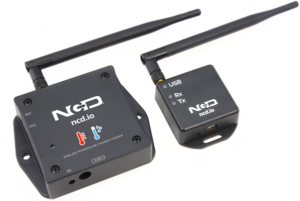
Getting Started
The sensor and Zigmo/Router come pre-programmed and work out of the box. In this section we will setup a sensor and Zigmo link and start receiving data on our PC. Though this guide shows how to visualize data on LabVIEW utility, you can also use a simple serial terminal to see raw data by following these steps.
Resources Required
- IoT Long Range Wireless Temperature Humidity Sensor (with power source Battery Or External DC)
- Zigmo/Router for PC (One Router will work with Multiple Sensors)
- PC/Laptop with an OS installed or Any IoT Embedded Device
- LabVIEW Utility for displaying sensor data (available on our website for free)
Steps
- Power-up the Wireless Sensor and make sure its antenna is installed
- Connect your Zigmo/Router to your PC

- Identify the serial port allocated to it by going into device manager (You can also find the serial port using Digi provided utility XCTU)
At this stage, both the Sensor and Zigmo have automatically established communication and the data can be read from the serial port at which Zigmo has been installed.

- Install the LabVIEW utility for the sensor you are working with. Run this utility.
- Press the port configure button and select the PORT you identified in step 3. Select baud rate of 115200 and press OK.

- Press the Run button to visualize incoming data
If you were not able to communicate after completing the above steps then there might be a fault at either end of the communication network. Please refer to the troubleshooting section for identifying and resolving some common issues. If you are still not able to communicate after troubleshooting then please contact us at any time.

Troubleshooting
Changed/Unknown setting at sensor end
One of the issues for unsuccessful communication can be a changed setting at the sensor end due to which the sensor and Zigmo are unable to establish a connection. You can resolve this problem by going back to the factory default settings which are provided in Table 1. Please refer to Figure 7 and follow steps shown in it for applying factory default settings.
Once the sensor resets it will start sending a frame every 600 seconds after factory reset.
One of the issues for unsuccessful communication can be a changed setting at the sensor end due to which the sensor and Zigmo are unable to establish a connection. You can resolve this problem by going back to the factory default settings which are provided in Table 1. Please refer to Figure 7 and follow steps shown in it for applying factory default settings.
Once the sensor resets it will start sending a frame every 600 seconds after factory reset.
Please refer to the detailed document available to Digi website to understand X-bee communication parameters and its operation mechanism.

Changed/Unknown setting at PC end
Sometimes a changed setting at Zigmo end, whether intentional or unintentional, can cause a network failure and no data reception at PC end. To fix this issue when the sensor end is operating at factory default settings you will have to bring the Zigmo/Router to factory default settings as well. For that, please download the configuration file for Zigmo from our website. You will also require XCTU utility provided by Digi.
After installing XCTU Utility, run it and go to add a radio module. Select the serial port at which Zigmo is connected and press finish. This will connect the Zigmo to XCTU.

After double clicking the added module, a list of parameters will be displayed on the right side. Select the load configuration file from the top and select configuration file form the location where you downloaded it earlier.
Now press the write button on top to write these parameters. Close the XCTU utility and open the LabVIEW utility and follow the steps in getting started section to communicate with sensor.

Modes of Operation
This module incorporates 2 modes of operation, these are
- Run Mode
- Configuration Mode
Run mode is the standard mode, the module will always enter Run mode if no button is pressed during Power-up/Reset. Configuration mode is intended to configure sensor parameters and the X-bee parameters on the sensor end. Note that the Sensor end X-bee is only configurable via the sensor controller using the commands provided in device manual. Figure 7 illustrates these modes.
The device sends a startup packet which can be used to determine the mode in which it is operating. These packets are shown in Table 2.
Mode Selection Process
The CFG button on the module is used to change mode. If CFG button is pressed and the module reset button is pressed, the module will enter the configuration mode. The amount of time CFG button has to be pressed is shown in Figure 7.
Note that settings only take effect after the reset.

Frame Communication at Power up
In figure 8, Mode bytes highlighted in red can be compared with the values provided in Table 2 to determine the mode in which the sensor is operating. Node ID is the ID of the given sensor while sensor type determines the type of sensor. Both of these can be used to determine the exact sensor which is sending the information.
A shown in second column in Table 2, the sensor configures its PAN ID automatically depending upon the mode it is working in. During factory reset it sets the PAN ID to the value given in table therefore the factory reset frame will only be received if your Zigmo/Router PAN ID matches this ID. Please note that right after factory reset the sensor enters configuration mode therefore its PAN ID is changed again and a new frame is generated. All 3 type of frames are shown in Figure 9, Figure 10 and Figure 11.
The factory default settings are shown in Table 1. For parameter description please refer to the section on configuration.


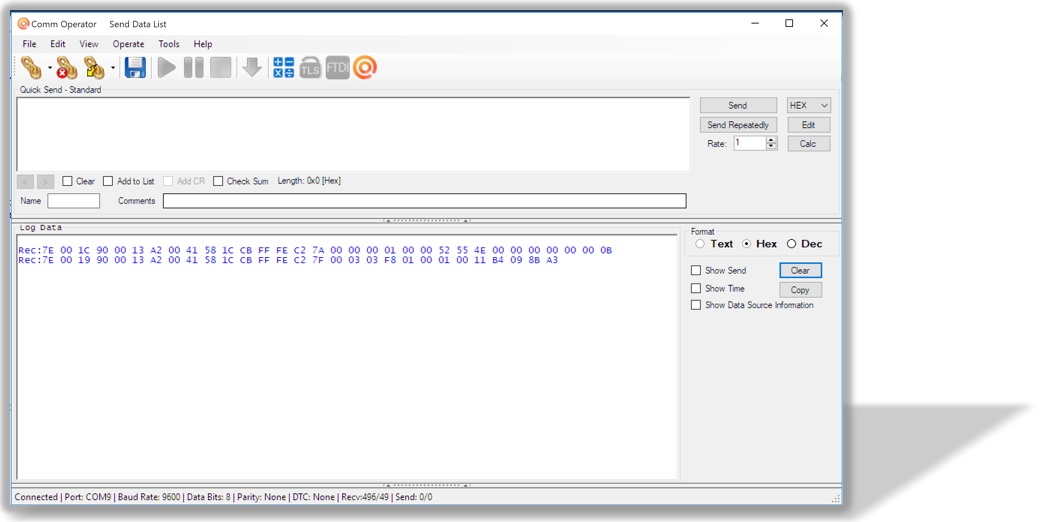
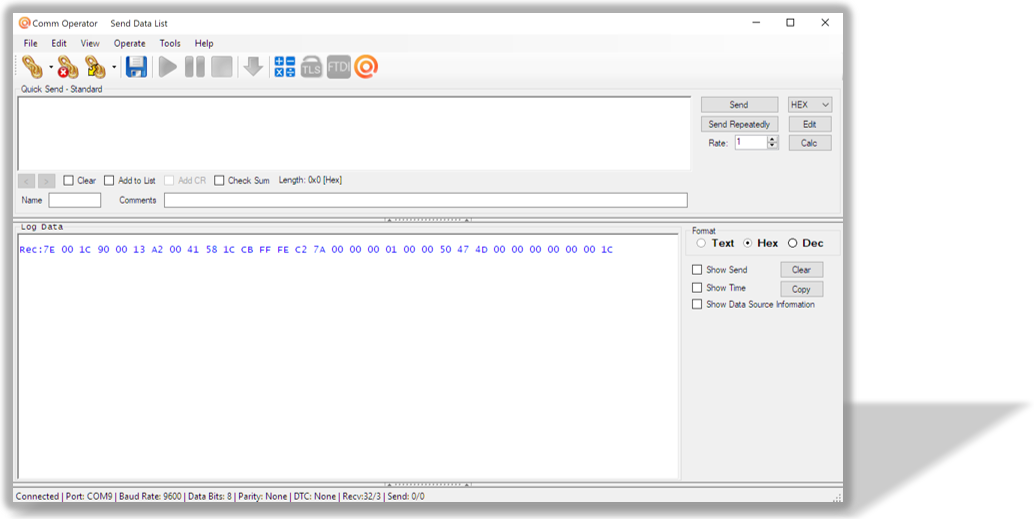

Run Mode
Run mode is the default mode of operation of this sensor. In this mode the sensor sends periodic packets to destination receiver. During the time it is not sending packets, it sleeps and conserves power. Sensor end X-bee operates in API mode and sends packets to the saved destination address on the network specified by the saved PAN ID. Figure 12 illustrates an API packet transmission and reception.
Packet reception at receiver end is ensured by the device by retrying up to 3 times if no acknowledgement is received that the packet has been successfully received. The device uses the acknowledgement functionality available in API mode in X-bee devices therefore user does not need to worry about sending acknowledgements for every packet.

The detail for API packet received at PC end can be read from the X-bee manual available from Digi. The detail of Payload section of packet is shown in Table 3.
Typical response from the device in Run mode is shown in Figure 13 and Figure 14. The utility shown in Figure 14 can be downloaded from the website.

The detail for API packet received at PC end can be read from the X-bee manual available from Digi. The detail of Payload section of packet is shown in Table 3.
Typical response from the device in Run mode is shown in Figure 13 and Figure 14. The utility shown in Figure 14 can be downloaded from the website.
| Frame Field | Offset (Payload Section) | Fixed Value (if any) | Description | ||
|---|---|---|---|---|---|
| Header | 0 | 0x7F |
| ||
| Node ID | 1 | 0x00 Factory Default |
| ||
| Firmware | 2 | – |
| ||
| Battery Voltage | MSB 3 | – | Sampled battery voltage of the device. Battery Voltage=((Battery Voltage MSB x 256+Battery Voltage LSB) x 0.00322 V | ||
| LSB 4 | – | ||||
| Packet Counter | 5 | – |
| ||
| Sensor Type | MSB 6 | 0x00 |
| ||
| MSB 7 | 0x01 | ||||
| Reserved | 8 | 0x00 |
| ||
| Sensors Data | MSB 9/ Data[0] | 0x00 | Humidity data Humidity(usigned) = ((data[0] x 256) + data[1])/100 | ||
| 10/ Data[1] | 0x01F | ||||
| 11/ Data[2] | 0x00 | Temperature data Temperature(signed) = (((data[2] x 256) + data[3])/100)°C | |||
| LSB 12/ Data[3] | 0xAA |
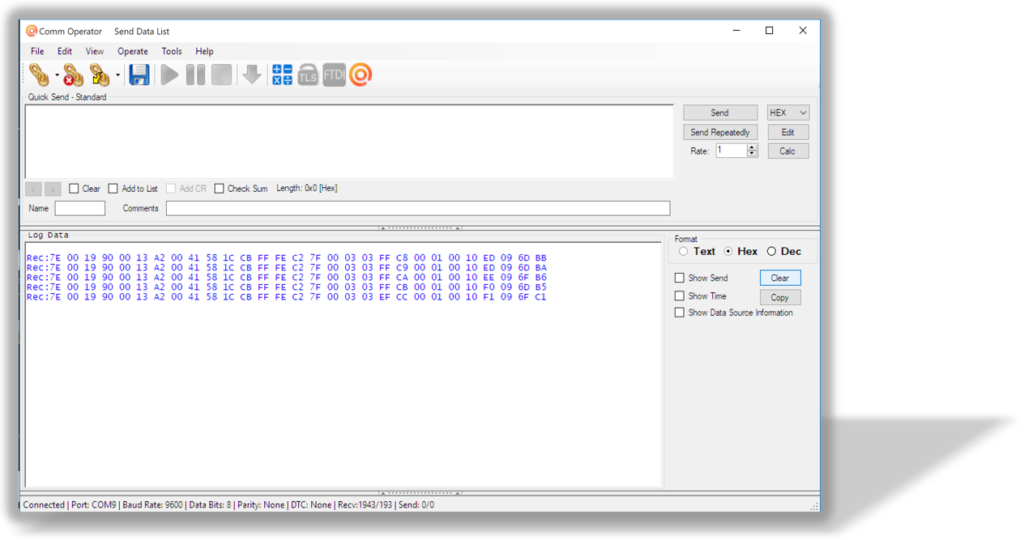
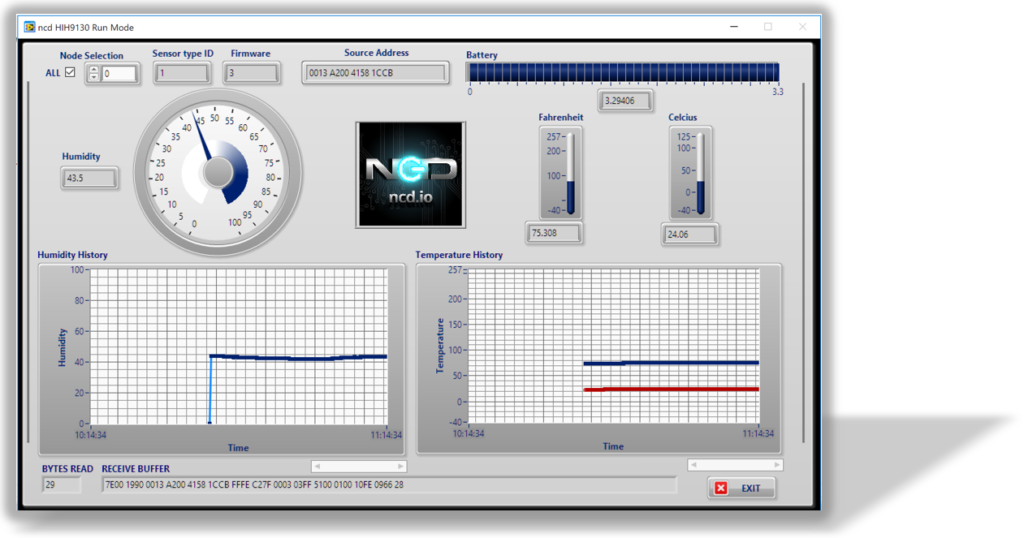
Configuration Mode
Configuration mode is intended to setup the device over the wireless link. Entering configuration mode was already explained in the section “mode selection procedure”. User can also setup X-bee communication and networking parameters using this mode via PC. Note that settings only take effect after reset and are stored inside the device.
In configuration mode, the device sets its X-bee pan id to 7BCD (Hex). Also, the destination address used by the sensor is broadcast (0000FFFF). This ensures that once you put a device in configuration mode you just need to change the PAN ID of your Zigmo to match with sensor and start configuring your device. You can change the PAN ID of your Zigmo using XCTU from Digi. If you use our LabVIEW utility, it will automatically change Zigmo PAN ID once you open the configuration window. When you exit this window your PAN ID will be restored to old value.
A standard configuration packet and its fields are explained in Figure 15. Its possible responses are also shown. The commands supported by this sensor are shown in Table 4, these can be used in the Parameters field of Payload section. The sensor responds to these commands with an acknowledgement if the process completed successfully or with an error if it failed to setup a parameter. The respective Data and Reserve section length and values are shown in Table 5 for the case of acknowledgement. In the case of error, the reserved section will be fixed and not used, while the Error number byte will determine the type of error returned. These errors are mentioned in Table 6.
Figure 15 depicts standard communication between Zigmo/Router and sensor. Sensor commands have variable length frames whereas responses received from sensor are fixed length. The 2 scenarios are also shown, where a command can result in an acknowledgement reception or an error reception at the Zigmo end.
Examples for setting parameters in configuration mode are shown in Appendix A.




Appendix A
Configuration Commands
1. Set Broadcast Transmission
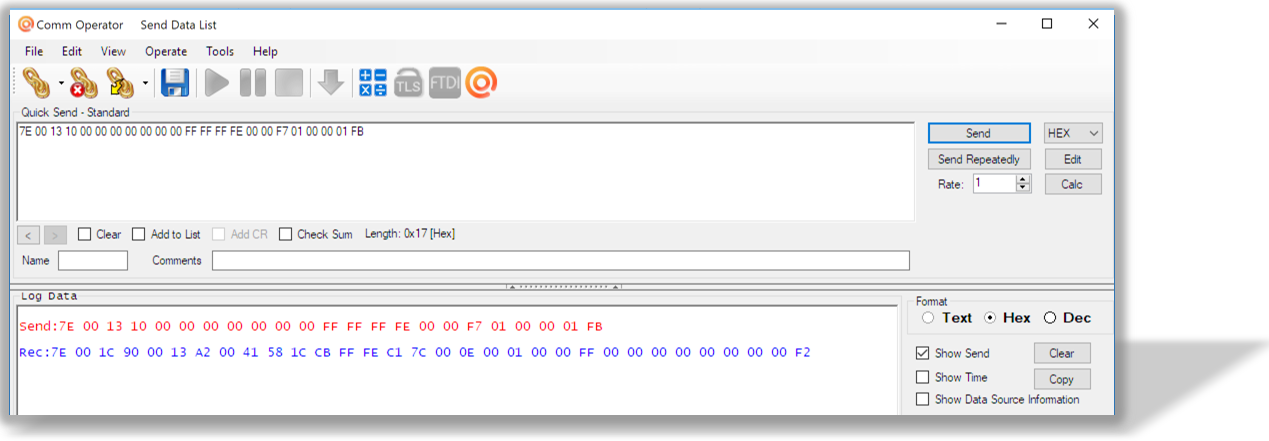

Command For COPY: 7E00 1310 0000 0000 0000 00FF FFFF FE00 00F7 0100 0001 FB
2. Set ID and Delay
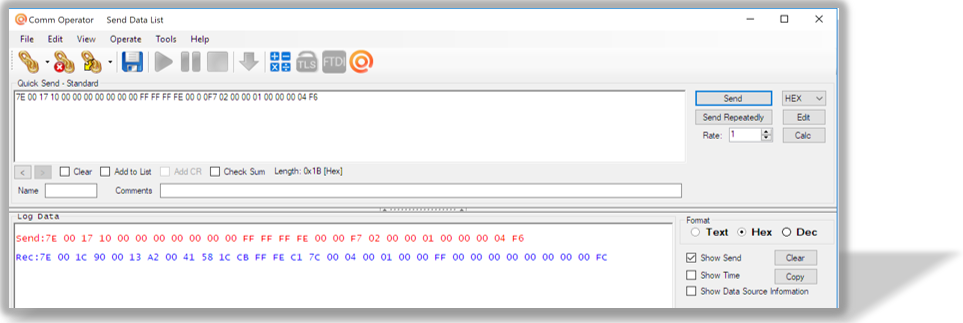
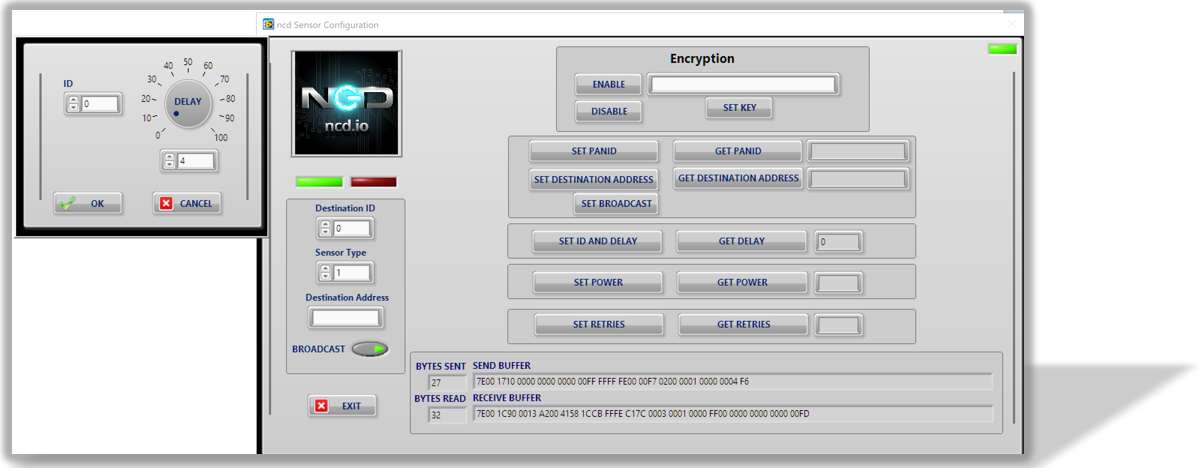
Command For COPY: 7E00 1710 0000 0000 0000 00FF FFFF FE00 00F7 0200 0001 0000 0004 F6
3. Set Destination Address

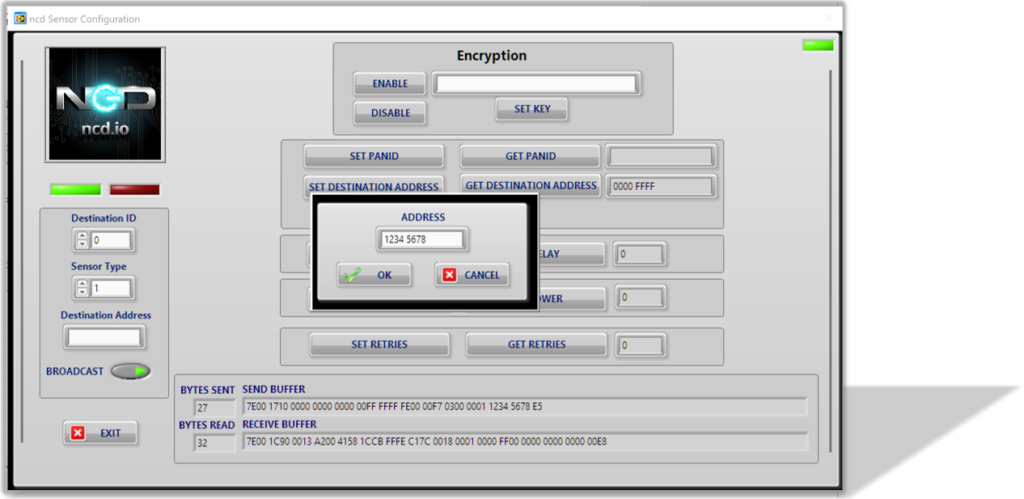
Command For COPY: 7E00 1710 0000 0000 0000 00FF FFFF FE00 00F7 0300 0001 1234 5678 E5
4. Set Power

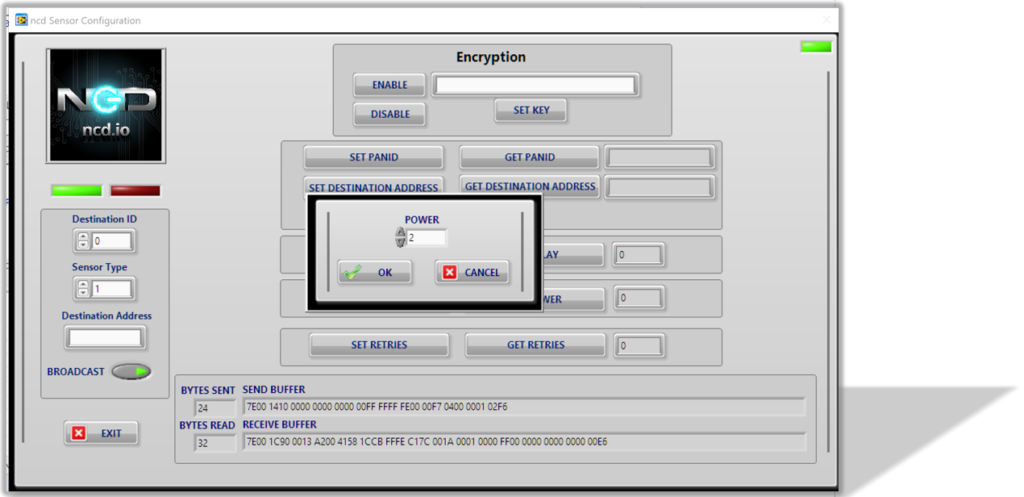
Command For COPY: 7E00 1410 0000 0000 0000 00FF FFFF FE00 00F7 0400 0001 02F6
5. Set PANID

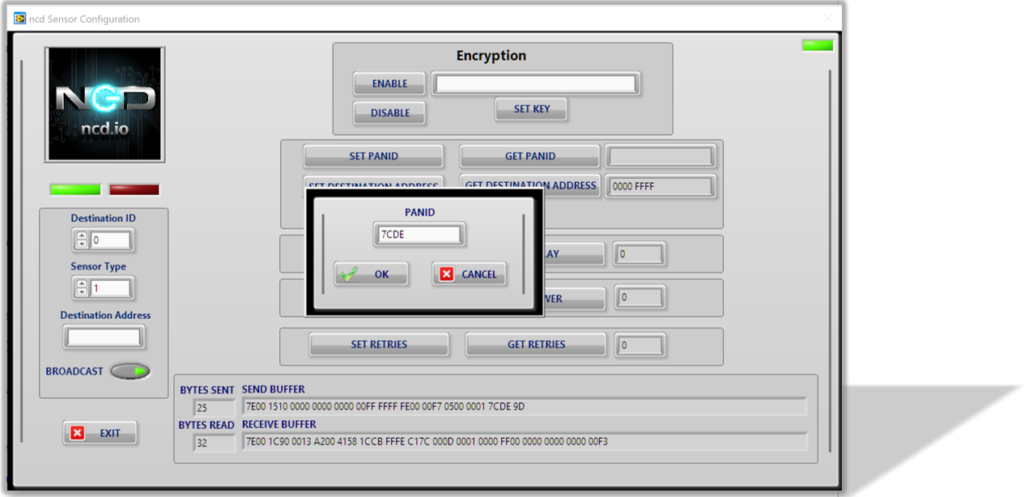
Command For COPY: 7E00 1510 0000 0000 0000 00FF FFFF FE00 00F7 0500 0001 7CDE 9D
6. Set Retries

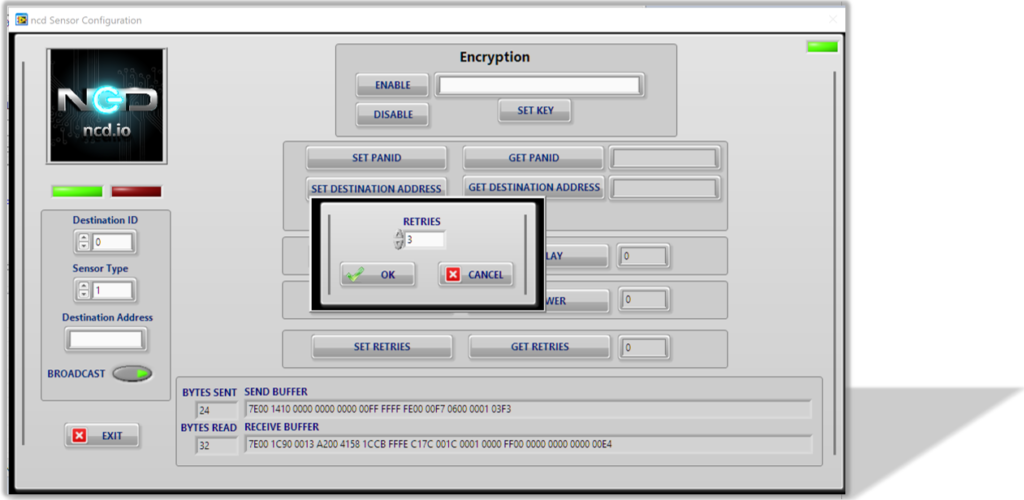
Command For COPY: 7E00 1410 0000 0000 0000 00FF FFFF FE00 00F7 0600 0001 03F3
7. Read Delay
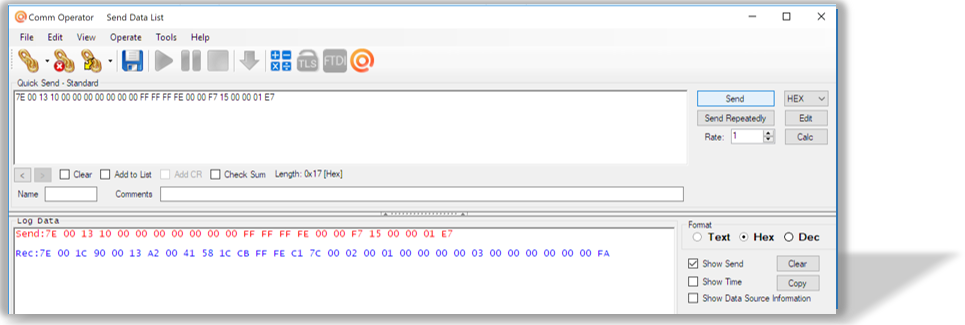

Command For COPY: 7E00 1410 0000 0000 0000 00FF FFFF FE00 00F7 0600 0001 03F3
8. Read Power
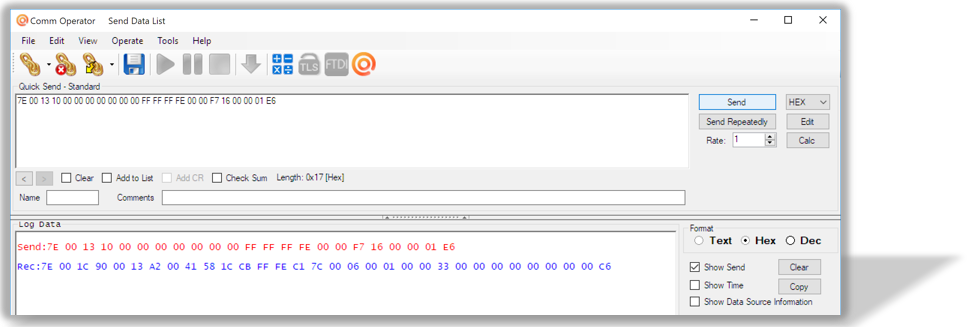
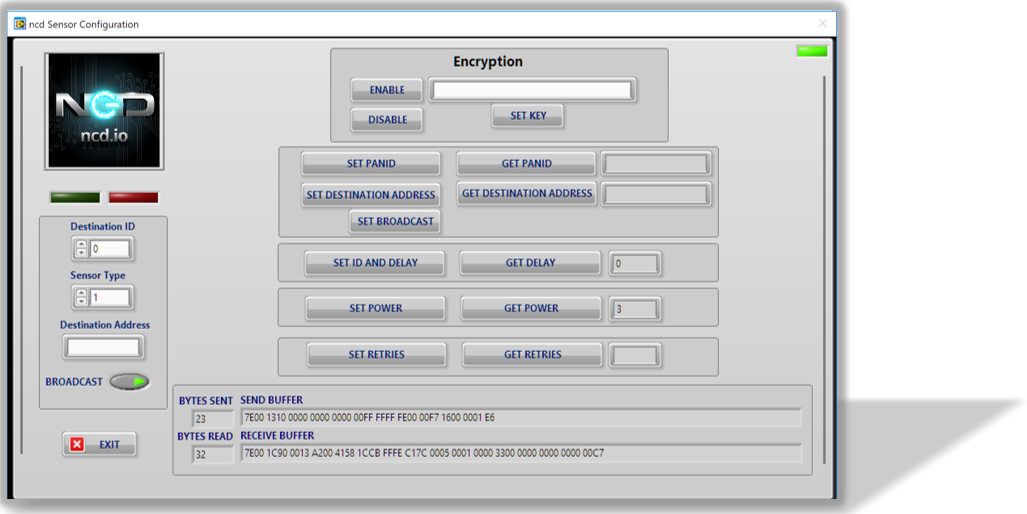
Command For COPY: 7E00 1310 0000 0000 0000 00FF FFFF FE00 00F7 1600 0001 E6
9. Read Retries
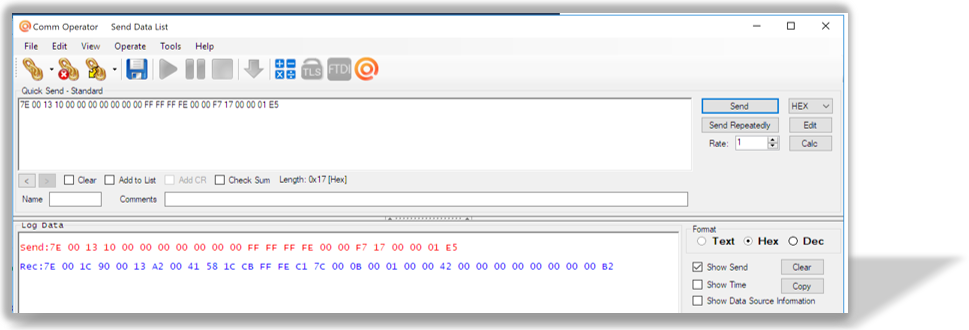
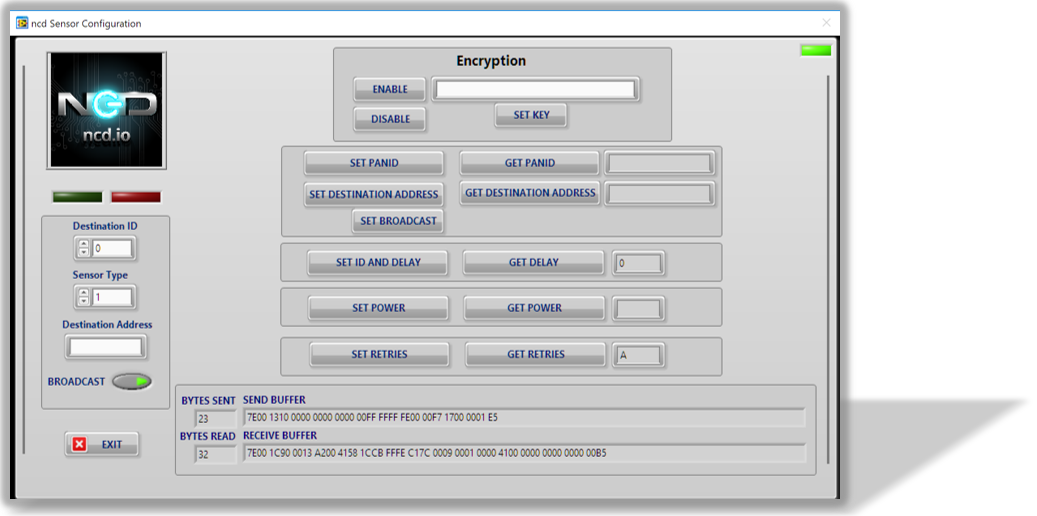
Command For COPY: 7E00 1310 0000 0000 0000 00FF FFFF FE00 00F7 1700 0001 E5
10. Read Destination Address
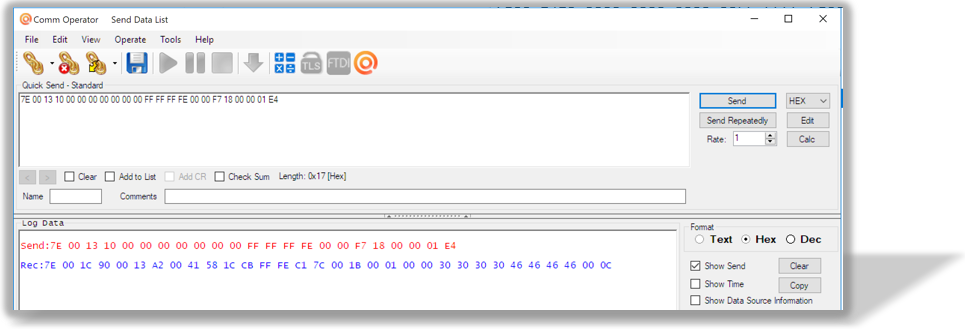
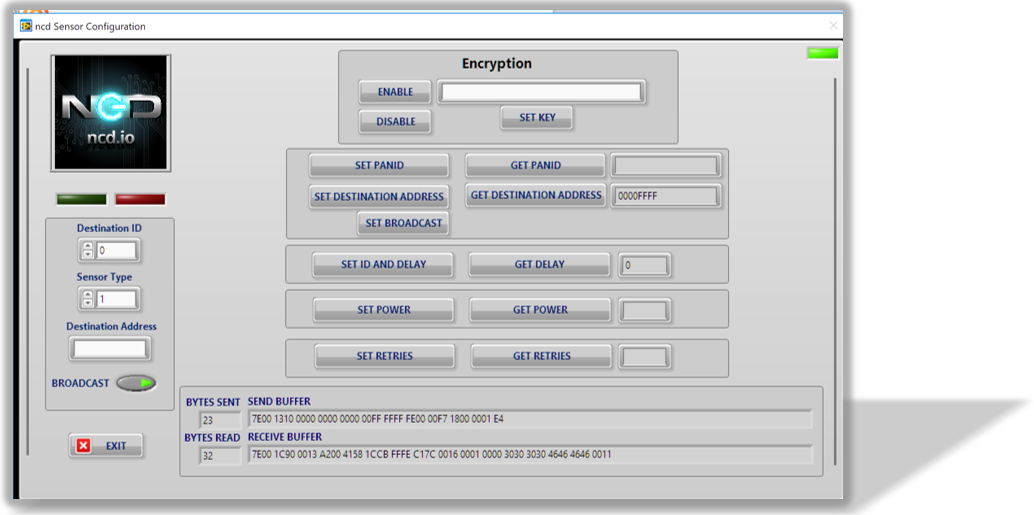
Command For COPY: 7E00 1310 0000 0000 0000 00FF FFFF FE00 00F7 1800 0001 E4
11. Read PANID
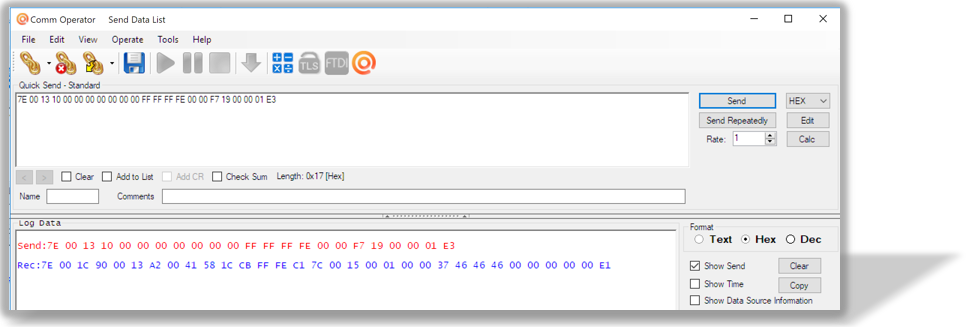
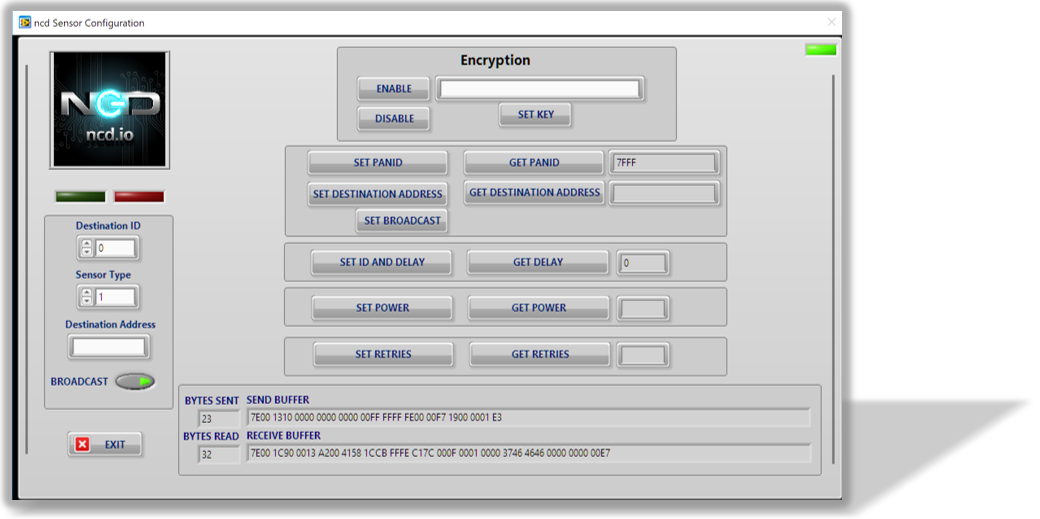
Command For COPY: 7E00 1310 0000 0000 0000 00FF FFFF FE00 00F7 1900 0001 E3
12. Enable Encryption
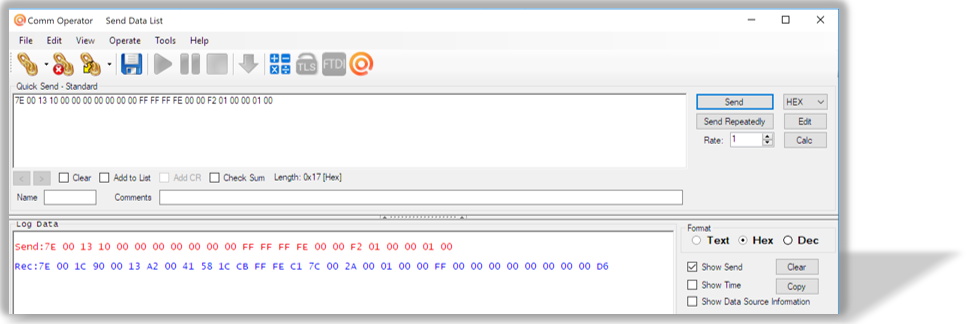
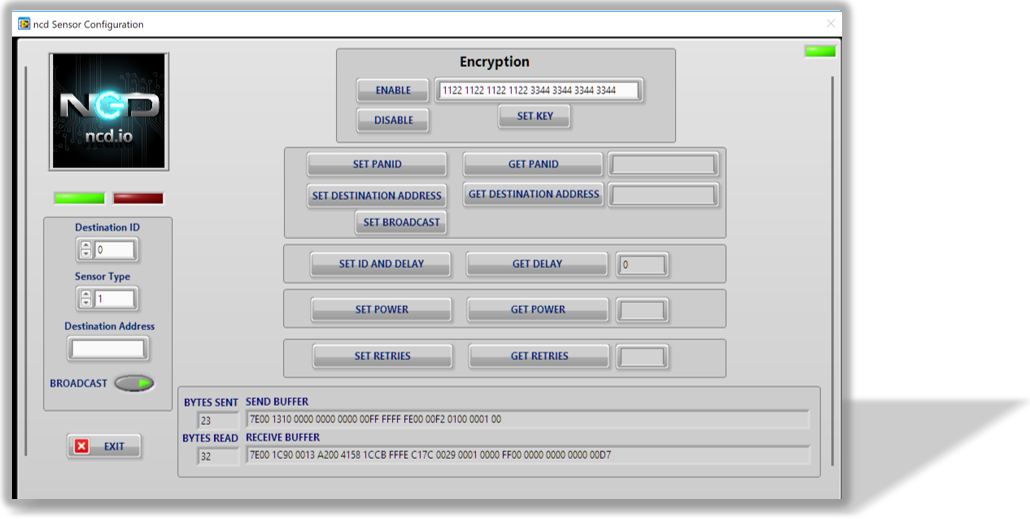
Command For COPY: 7E00 1310 0000 0000 0000 00FF FFFF FE00 00F2 0100 0001 00
13. Disable Encryption


Command For COPY: 7E00 1310 0000 0000 0000 00FF FFFF FE00 00F2 0200 0001 FF
14. Set Encryption Key
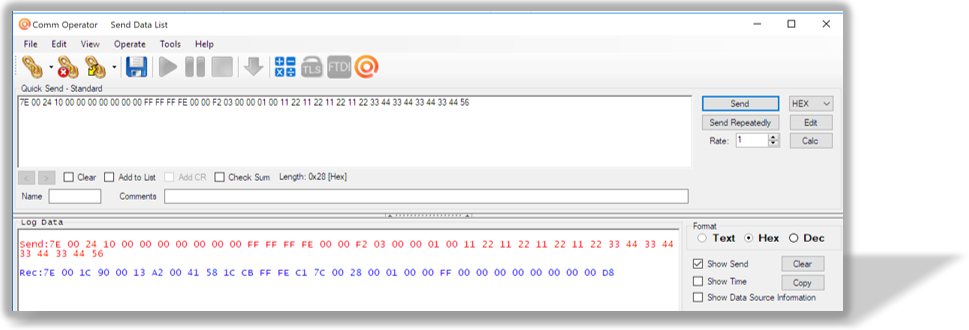
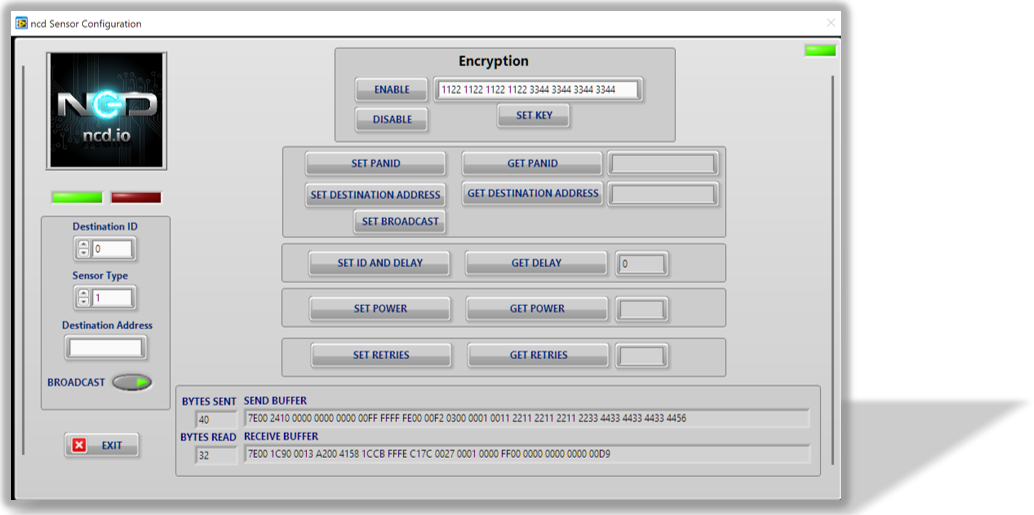
Command For COPY: 7E00 2410 0000 0000 0000 00FF FFFF FE00 00F2 0300 0001 0011 2211 2211 2211 2233 4433 4433 4433 4456
Appendix B
Frame Checksum Calculation
In order to successfully communicate over the API protocol, checksum is of vital importance. The X-bee at either end will reject packets if the checksum is not matched. Checksum is also checked by the sensor controller and LabVIEW utility for added security.
For sending packets, checksum calculation works as follows
- Not including the frame delimiter and length, add all the bytes and keep the lower 8 bits of result
- Subtract this value from 0xFF (hex)
- The resultant value is the checksum
- Append this byte to the original packet for sending
Consider the example for the command Set Broadcast shown in Figure 19 in A APPENDIX and see that the calculated checksum matches with the checksum sent by the terminal/LabVIEW

Although checksum is matched by the X-bee itself, but for understanding follow these steps to match checksum at reception
- Not including the frame delimiter and length, add all the bytes including the received checksum
- Keep only the last 8 bits
- If the result is 0xFF, the checksum is correct and the packet can be processed.
Consider the example of the command Set Broadcast shown in Figure 19 in A APPENDIX and see that the received packet checksum verifies since the result is 0xFF.

Features
- Industrial Grade Sensor with µs latency
- Sleeps when no push input detected
- 1-Mile Range with 2.4GHz or 2 Mile Range with 900MHz On-Board Antenna
- Superior LOS Range of up to 28 miles with 900MHz High-Gain Antennas
- Interface to Raspberry Pi, Microsoft Azure, Arduino and More
- Example Software for Visual Studio and LabVIEW
- Wireless Mesh Networking using DigiMesh®
- 256 Sensor Node per Network
- Open Communication Protocol for custom interfacing applications
- Small Form Factor Wireless Sensor (3×3 inch)
- Two modes of Operation
- Configuration mode for Sensor and X-bee Settings
- Factory Default Option using combination of hardware buttons
- Power efficient Built-in Sleep mode
- User Configurable Sleep duration
- Up to 500,000 Transmissions from 2 AA Batteries
- X-bee API mode use for reliable communication
- Improved reliability incorporating Re try feature in case of packet loss
- Real time battery status
This manual is divided into the following sections:
- Description
- Getting Started
- Troubleshooting
- Modes of Operation
- Appendix A Configuration Commands
- Appendix B Frame Checksum Calculation
1. Description
Introducing NCD’s IoT Wireless Push Notification Sensor, boasting up to a 28 Mile range using a 900MHz wireless mesh networking architecture or 1 Mile using 2.4GHz wireless mesh networking architecture. It transmits highly accurate frames with low latency for every push input or at user-defined intervals.
Powered by just 2 AA batteries and an operational lifetime of 500,000 wireless transmissions, a 10 years battery life can be expected depending on environmental conditions and the data transmission interval. Optionally, this sensor may be externally powered.
With an open communication protocol this sensor can be integrated with just about any control system or gateway. Data can be transmitted to a PC, a Raspberry Pi, to Microsoft Azure® IoT, or Arduino. Sensor parameters and wireless transmission settings can be changed on the go using the open communication protocol providing maximum configurability depending on the intended application.
The range, price, accuracy, battery life and security features of Wireless Push Notification Sensor makes it an affordable choice which exceeds the requirements for most of the industrial as well as consumer market applications.
Note: This manual is shared with IoT Long Range Wireless 24V AC/DC Voltage Detection Sensor as well.
Applications
- Push Notification
- Wireless input change detection
- Digital signal monitoring
- Component of Low Power IoT System
- Home Automation
To complete a network with an industrial sensor at one end, a Zigmo/Router is required at the receiving end (PC end) that receives data from sensor. A set of sensor and Zigmo is shown in following figure.
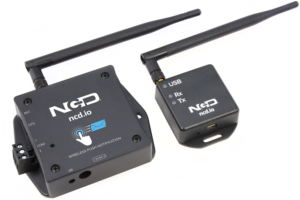
Sensor with Zigmo/Router
2. Getting Started
The sensor and Zigmo/Router come pre-programmed and work out of the box. In this section we will setup a sensor and Zigmo link and start receiving data on our PC. Though this guide shows how to visualize data on LabVIEW utility, you can also use a simple serial terminal to see raw data by following these steps.
Resources Required
- Push Notification Type Iot Wireless Sensor (with power source Battery Or External DC)
- Zigmo/Router for PC (One Router will work with Multiple Sensors)
- · PC/Laptop with an OS installed or Any IoT Embedded Device
- · LabVIEW Utility for displaying sensor data (available on our website for free)
Steps
- Power-up the Wireless Sensor and make sure its antenna is installed
- Connect your Zigmo/Router to your PC

- Identify the serial port allocated to it by going into device manager (You can also find the serial port using Digi provided utility XCTU)
At this stage, both the Sensor and Zigmo have automatically established communication and the data can be read from the serial port at which Zigmo has been installed.
a

a
a
a
a
- Install the LabVIEW utility for the sensor you are working with. Run this utility.
- Press the port configure button and select the PORT you identified in step 3. Select baud rate of 115200 and press OK.
a
a
a
a
a
a

a
a
a
a
a
a
- Press the Run button to visualize incoming data
If you were not able to communicate after completing the above steps then there might be a fault at either end of the communication network. Please refer to the troubleshooting section for identifying and resolving some common issues. If you are still not able to communicate after troubleshooting then please contact us at any time.




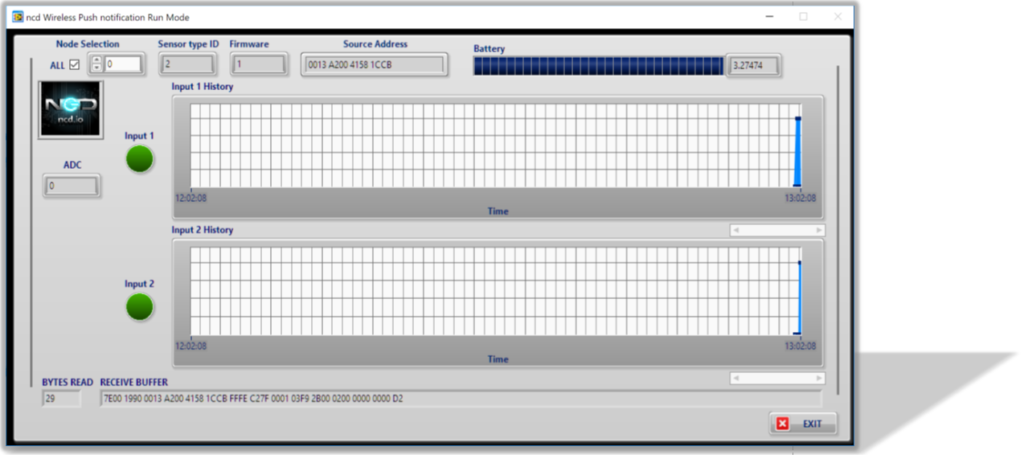
3. Troubleshooting
Changed/Unknown setting at sensor end
One of the issues for unsuccessful communication can be a changed setting at the sensor end due to which the sensor and Zigmo are unable to establish a connection. You can resolve this problem by going back to the factory default settings which are provided in Table 1. Please refer to Figure 7 and follow steps shown in it for applying factory default settings.
Once the sensor resets it will start sending a frame every 600 seconds after factory reset.
Please refer to the detailed document available to Digi website to understand X-bee communication parameters and its operation mechanism.
Changed/Unknown setting at PC end
Sometimes a changed setting at Zigmo end, whether intentional or unintentional, can cause a network failure and no data reception at PC end. To fix this issue when the sensor end is operating at factory default settings you will have to bring the Zigmo/Router to factory default settings as well. For that, please download the configuration file for Zigmo from our website. You will also require XCTU utility provided by Digi.
After installing XCTU Utility, run it and go to add a radio module. Select the serial port at which Zigmo is connected and press finish. This will connect the Zigmo to XCTU.
a
a
a
a
a
a
a
a
a
a
After double clicking the added module, a list of parameters will be displayed on the right side. Select the load configuration file from the top and select configuration file form the location where you downloaded it earlier.
Now press the write button on top to write these parameters. Close the XCTU utility and open the LabVIEW utility and follow the steps in getting started section to communicate with sensor.

Table 1: Default Parameters programmed after Factory reset sequence


4. Modes of Operation
This module incorporates 2 modes of operation, these are
- Run Mode
- Configuration Mode
Run mode is the standard mode, the module will always enter Run mode if no button is pressed during Power-up/Reset. Configuration mode is intended to configure sensor parameters and the X-bee parameters on the sensor end. Note that the Sensor end X-bee is only configurable via the sensor controller using the commands provided in device manual. Figure 7 illustrates these modes.
The device sends a startup packet which can be used to determine the mode in which it is operating. These packets are shown in Table 2.
Mode Selection Process
The CFG button on the module is used to change mode. If CFG button is pressed and the module reset button is pressed, the module will enter the configuration mode. The amount of time CFG button has to be pressed is shown in Figure 7.
Note that settings only take effect after the reset.
Frame Communication at Power up
In figure 8, Mode bytes highlighted in red can be compared with the values provided in Table 2 to determine the mode in which the sensor is operating. Node ID is the ID of the given sensor while sensor type determines the type of sensor. Both of these can be used to determine the exact sensor which is sending the information.
A shown in second column in Table 2, the sensor configures its PAN ID automatically depending upon the mode it is working in. During factory reset it sets the PAN ID to the value given in table therefore the factory reset frame will only be received if your Zigmo/Router PAN ID matches this ID. Please note that right after factory reset the sensor enters configuration mode therefore its PAN ID is changed again and a new frame is generated. All 3 type of frames are shown in Figure 9, Figure 10 and Figure 11.
The factory default settings are shown in Table 1. For parameter description please refer to the section on configuration.



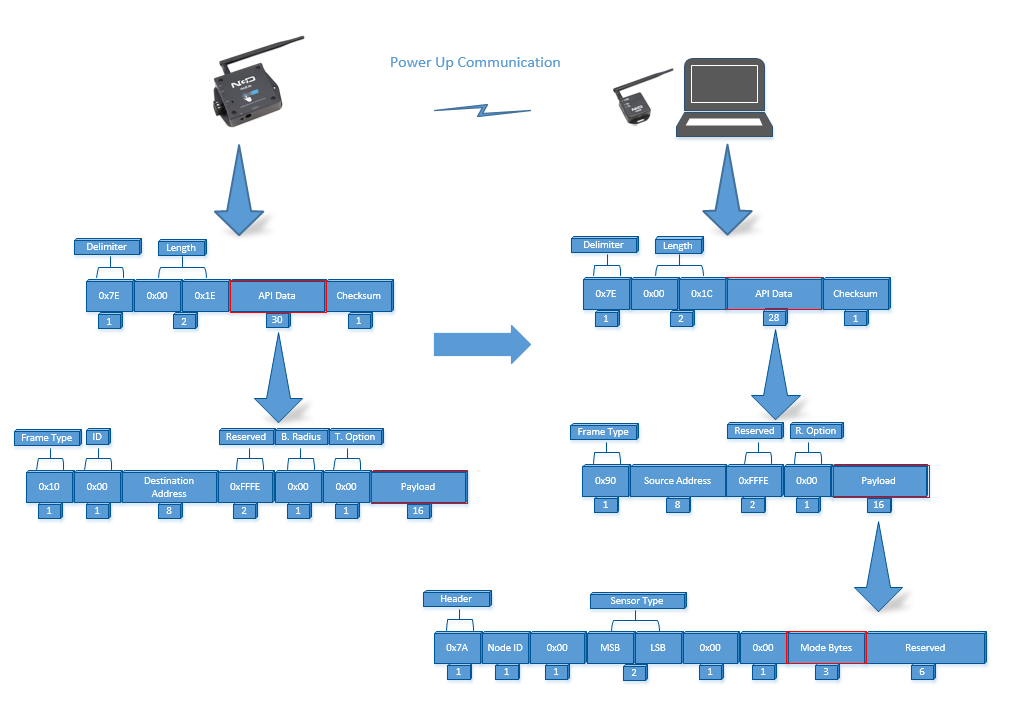
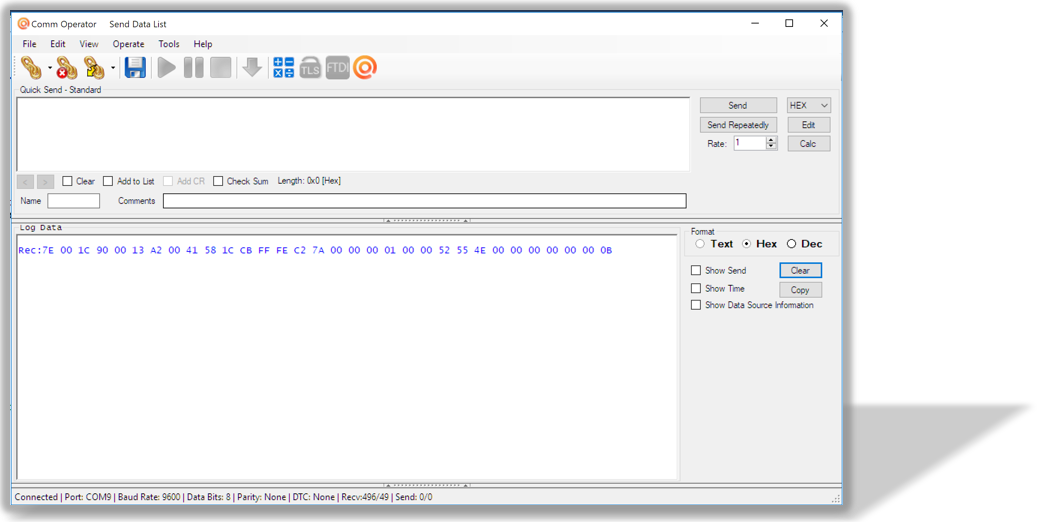
Figure 9: Run Mode Power up frame

Figure 10: Configuration Mode Power up frame

Figure 11: Factory Default Power up frame
1. Run Mode
Run mode is the default mode of operation of this sensor. In this mode the sensor sends periodic packets to destination receiver. During the time it is not sending packets, it sleeps and conserves power. Sensor end X-bee operates in API mode and sends packets to the saved destination address on the network specified by the saved PAN ID. Figure 12 illustrates an API packet transmission and reception.
Packet reception at receiver end is ensured by the device by retrying up to 3 times if no acknowledgement is received that the packet has been successfully received. The device uses the acknowledgement functionality available in API mode in X-bee devices therefore user does not need to worry about sending acknowledgements for every packet.
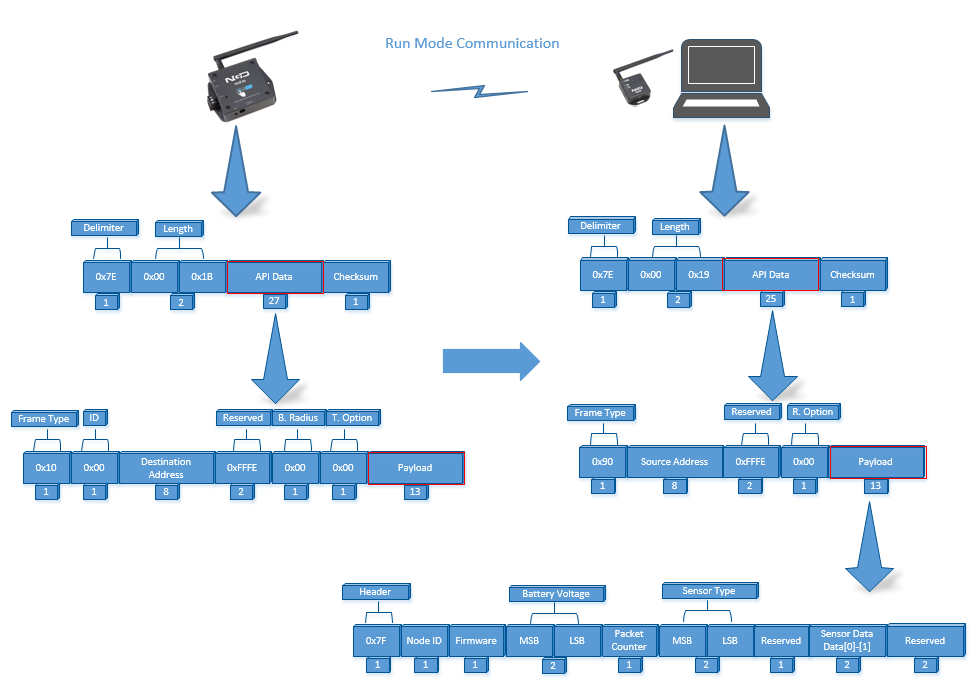
a
a
The detail for API packet received at PC end can be read from the X-bee manual available from Digi. The detail of Payload section of packet is shown in Table 3.
Typical response from the device in Run mode is shown in Figure 13 and Figure 14. The utility shown in Figure 14 can be downloaded from the website.

The detail for API packet received at PC end can be read from the X-bee manual available from Digi. The detail of Payload section of packet is shown in Table 3.
Typical response from the device in Run mode is shown in Figure 13 and Figure 14. The utility shown in Figure 14 can be downloaded from the website.
| Frame Field | Offset (Payload Section) | Fixed Value (if any) | Description | |
|---|---|---|---|---|
| Header | 0 | 0x7F | Header to differentiate various type of packets | |
| Node ID | 1 | 0x00 Factory Default |
| |
| Firmware | 2 | – |
| |
| Battery Voltage | MSB 3 | – | Sampled battery voltage of the device. Battery Voltage=((Battery Voltage MSB x 256+Battery Voltage LSB) x 0.00322 V | |
| LSB 4 | – | |||
| Packet Counter | 5 | – |
| |
| Sensor Type | MSB 6 | 0x00 |
| |
| MSB 7 | 0x02 | |||
| Reserved | 8 | 0x00 |
| |
| Sensors Data | 9/Data[0] | – | Input 1 – High Input: 1, Low Input: 0 | |
| Sensors Data | 10/Data[1] | – | Input 2 – High Input: 1, Low Input: 0 | |
| Reserved | 11 | 0x00 | ||
| 12 | 0x00 |

Figure 13: Run mode packets being received in a terminal (Hex mode)

Figure 14: Run mode packets being received in our free to use LabVIEW utility (For custom made utility for your specific requirements please contact support)
2. Configuration Mode
Configuration mode is intended to setup the device over the wireless link. Entering configuration mode was already explained in the section “mode selection procedure”. User can also setup X-bee communication and networking parameters using this mode via PC. Note that settings only take effect after reset and are stored inside the device.
In configuration mode, the device sets its X-bee pan id to 7BCD (Hex). Also, the destination address used by the sensor is extracted from the incoming packet (source address). This ensures that once you put a device in configuration mode you just need to change the PAN ID of your Zigmo to match with sensor and start configuring your device. You can change the PAN ID of your Zigmo using XCTU from Digi. If you use our LabVIEW utility, it will automatically change Zigmo PAN ID once you open the configuration window. When you exit this window your PAN ID will be restored to old value.
A standard configuration packet and its fields are explained in Figure 15. Its possible responses are also shown. The commands supported by this sensor are shown in Table 4, these can be used in the Parameters field of Payload section. The sensor responds to these commands with an acknowledgement if the process completed successfully or with an error if it failed to setup a parameter. The respective Data and Reserve section length and values are shown in Table 5 for the case of acknowledgement. In the case of error, the reserved section will be fixed and not used, while the Error number byte will determine the type of error returned. These errors are mentioned in Table 6.
Figure 15 depicts standard communication between Zigmo/Router and sensor. Sensor commands have variable length frames whereas responses received from sensor are fixed length. The 2 scenarios are also shown, where a command can result in an acknowledgement reception or an error reception at the Zigmo end.
Examples for setting parameters in configuration mode are shown in Appendix A.


Table 4: Configuration Commands and their respective headers, sub command and Parameter field

Table 5: Acknowledgment data for various commands and the size of reserve section in each case

Table 6: Error numbers and their description
A. Appendix

Configuration Commands
1. Set Broadcast Transmission


Command For COPY: 7E00 1310 0000 0000 0000 00FF FFFF FE00 00F7 0100 0002 FA
2. Set ID and Delay


Command For COPY: 7E00 1710 0000 0000 0000 00FF FFFF FE00 00F7 0200 0002 0000 0004 F5
3. Set Destination Address


Command For COPY:
7E00 1710 0000 0000 0000 00FF FFFF FE00 00F7 0300 0002 1234 5678 E4
4. Set Power

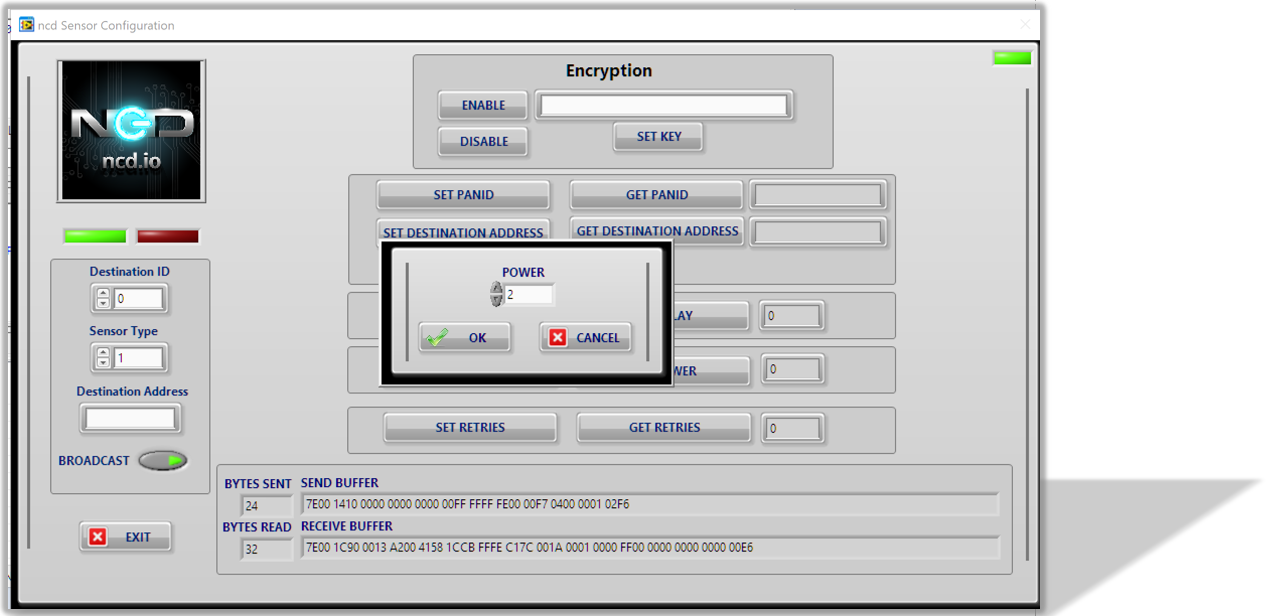
Command For COPY: 7E00 1410 0000 0000 0000 00FF FFFF FE00 00F7 0400 0002 02F5
5. Set PANID

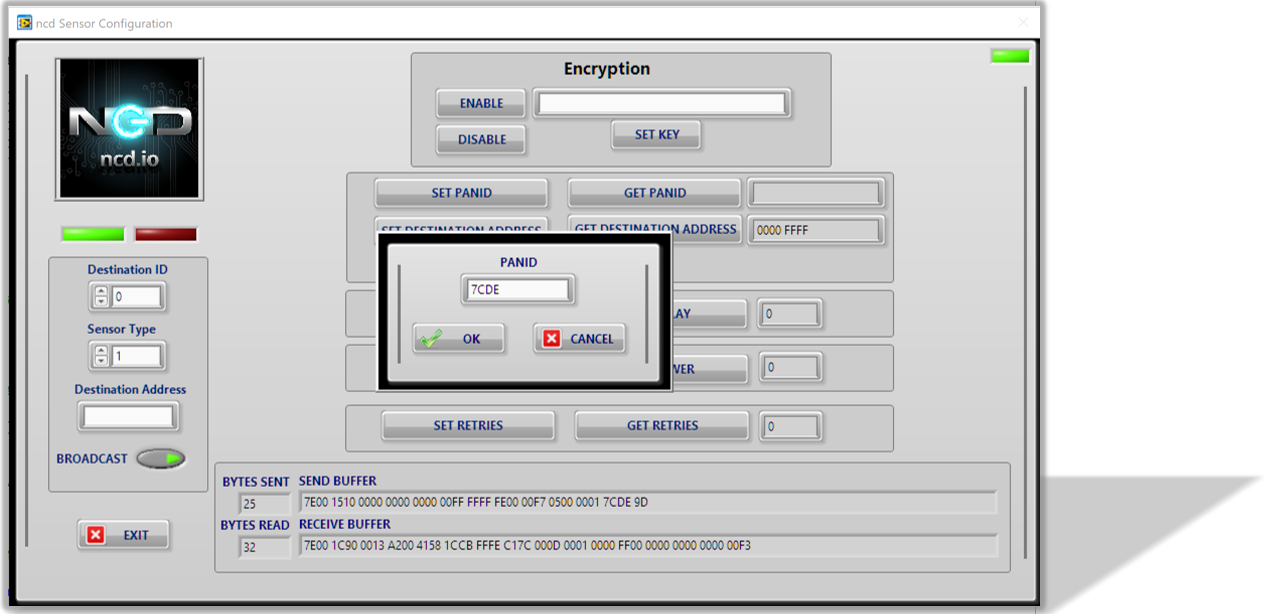
Command For COPY: 7E00 1510 0000 0000 0000 00FF FFFF FE00 00F7 0500 0002 7CDE 9C
6. Set Retries

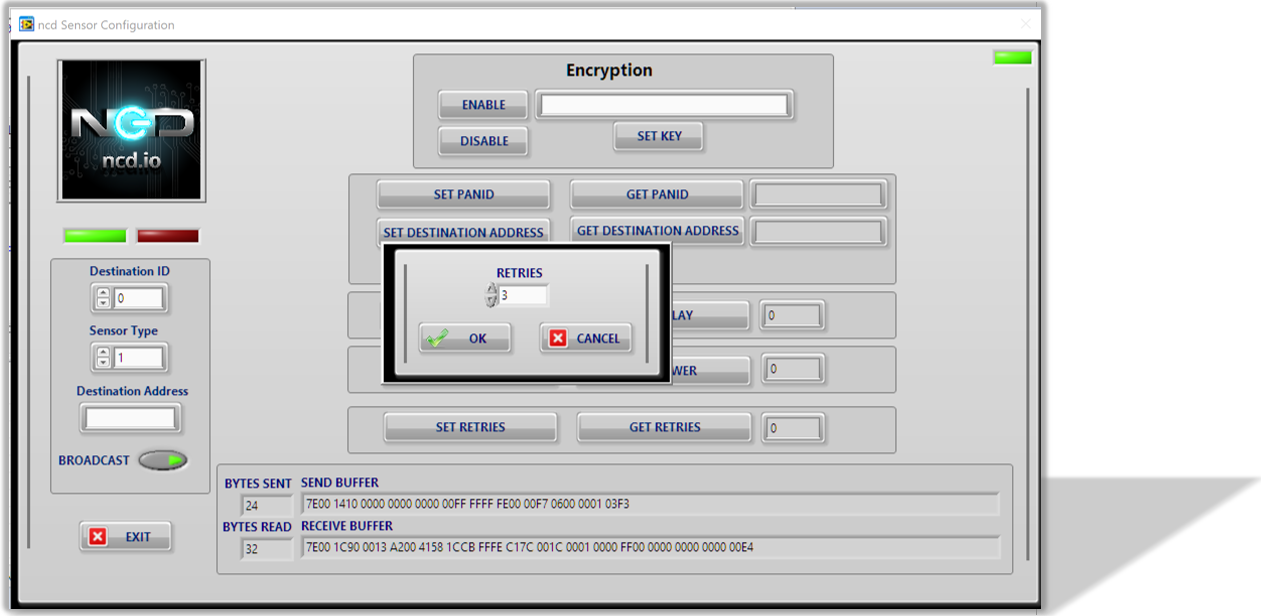
Command For COPY: 7E00 1410 0000 0000 0000 00FF FFFF FE00 00F7 0600 0002 03F2
7. Read Delay

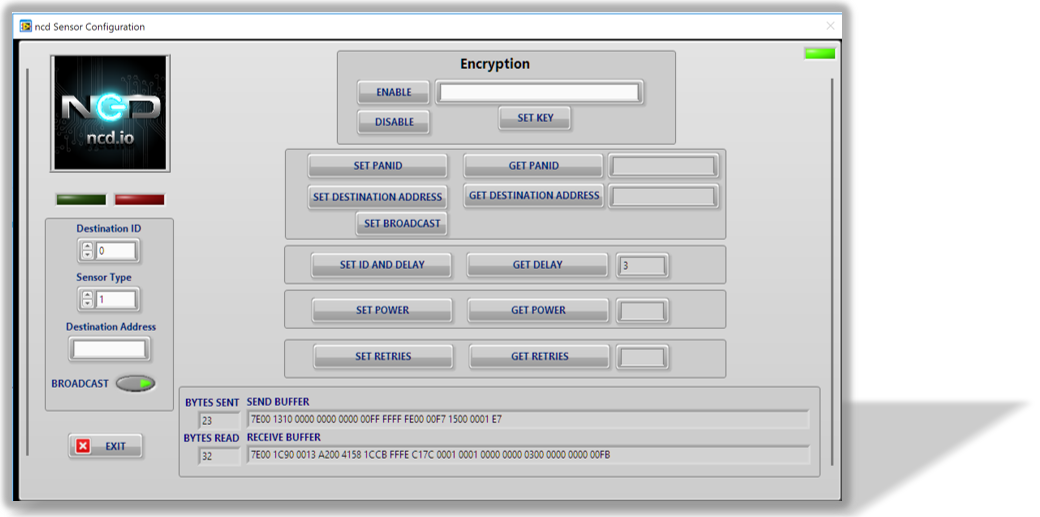
Command For COPY: 7E00 1310 0000 0000 0000 00FF FFFF FE00 00F7 1500 0002 E6
8. Read Power


Command For COPY: 7E00 1310 0000 0000 0000 00FF FFFF FE00 00F7 1600 0002 E5
9. Read Retries


Command For COPY: 7E00 1310 0000 0000 0000 00FF FFFF FE00 00F7 1700 0002 E4
10. Read Destination Address


Command For COPY: 7E00 1310 0000 0000 0000 00FF FFFF FE00 00F7 1800 0002 E3
11. Read PANID


Command For COPY: 7E00 1310 0000 0000 0000 00FF FFFF FE00 00F7 1900 0002 E2
12. Enable Encryption


Command For COPY: 7E00 1310 0000 0000 0000 00FF FFFF FE00 00F2 0100 0002 FF
13. Disable Encryption


Command For COPY: 7E00 1310 0000 0000 0000 00FF FFFF FE00 00F2 0200 0002 FE
14. Set Encryption Key


Command For COPY:
7E00 2410 0000 0000 0000 00FF FFFF FE00 00F2 0300 0002 0011 2211 2211 2211 2233 4433 4433 4433 4455
B. Appendix
Frame Checksum Calculation
In order to successfully communicate over the API protocol, checksum is of vital importance. The X-bee at either end will reject packets if the checksum is not matched. Checksum is also checked by the sensor controller and LabVIEW utility for added security.
For sending packets, checksum calculation works as follows
- Not including the frame delimiter and length, add all the bytes and keep the lower 8 bits of result
- Subtract this value from 0xFF (hex)
- The resultant value is the checksum
- Append this byte to the original packet for sending
Consider the example for the command Set Broadcast shown in Figure 19 in A APPENDIX and see that the calculated checksum matches with the checksum sent by the terminal/LabVIEW

Although checksum is matched by the X-bee itself, but for understanding follow these steps to match checksum at reception
- Not including the frame delimiter and length, add all the bytes including the received checksum
- Keep only the last 8 bits
- If the result is 0xFF, the checksum is correct and the packet can be processed.
Consider the example of the command Set Broadcast shown in Figure 19 in A APPENDIX and see that the received packet checksum verifies since the result is 0xFF.

| Battery | |
| Transmissions Per Hour | |
| Expected Battery Life |

